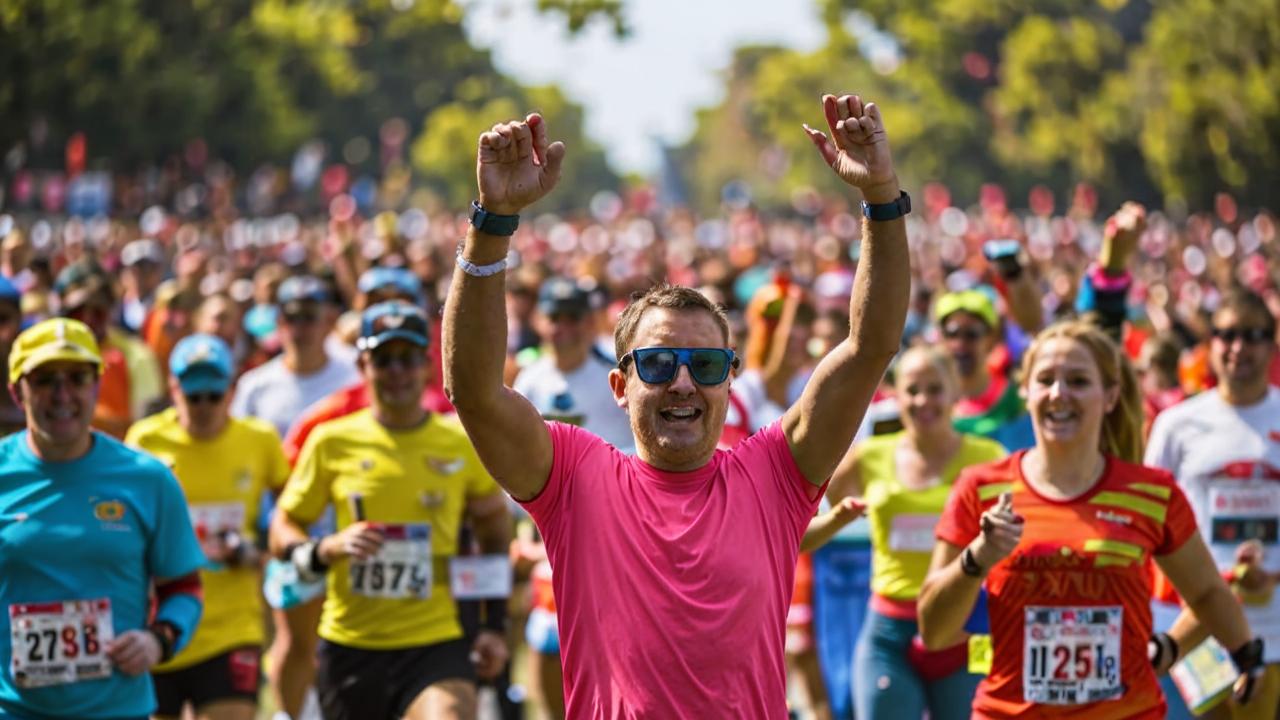The White Nights Marathon is a landmark project, in which more and more people take part every year. And the reason for its popularity is simple: it is not often that you get the opportunity to run through the night streets of St. Petersburg. The city is especially beautiful during the White Nights.
White Nights are a unique natural phenomenon observed before and after the summer solstice. During this period the night consists only of twilight, the city does not plunge into complete darkness.

race director, co-founder of the Running Community
“Participants should expect vivid emotions and impressions. We are sure that everyone will have a great time, because the white nights themselves are a unique natural phenomenon that fills the city with a special magic. We hope that the weather this year will be comfortable, and the start in the evening, when it is not so hot, will allow to run in pleasure, to enjoy the unique route”.
History of the marathon
In 1990 the first international marathon “White Nights” took place. At that time 471 people from 83 cities of the USSR came to the start, for that time the race had quite a wide geography: athletes came from Great Britain, the USA and Germany. The sports program included a marathon distance and a 10 km run.
The 1992 race also became a landmark: it was then that a record was set among men at a distance of 10 km. Dmitry Kapitonov became the holder, the result was 28.59. If we talk about the marathon distance, the record since 2003 for Nikolai Kerimov, his result – 2:11.46. In the same year the best female result at the 10-kilometer distance was also recorded – Yulia Gromova overcame it in 32.05.
In 1995, the start of the race was given at 19:00, and then moved to the first half of the day. In 2022 the Running Community joined the list of organizers for the first time, and the marathon began to be held at night. The following year, the course became linear for the first time, with the finish and start located in different places. The first relay race in the history of the marathon also took place.
In addition, in 2023, records were set in the recent history of the marathon. Among women Luiza Dmitrieva took the lead, she ran 42.2 km in 2:29.48. On a shorter, but no less significant 10-kilometer race the best was Anna Vikulova with a result of 32.11. Men, of course, can also boast excellent results: Konstantin Plokhotnikov overcame 10 km in 29.12, and Alexey Reunkov overcame the marathon distance in 2:13.35.

What is the peculiarity of the White Nights Marathon in 2024?
This year White Nights joined the BRICS Marathon League, which was established last year at the St. Petersburg International Economic Forum. For some participants who ran the first marathon in the series (Kazan Marathon), the White Nights will be the second stage. There are more than 400 such people. On June 29, they will overcome the distance for the second time in two months and will receive an exclusive commemorative badge after the finish.
TheBRICS Marathon League is a project that unites the largest marathons in Russia, held in Moscow, St. Petersburg and Kazan. In the future, marathons from Brazil, India, China, South Africa and other BRICS countries will join them.
It is important to note that many guests of the city are preparing to start – about 80% of participants will come to St. Petersburg especially for the White Nights. And this only shows that the marathon attracts the attention of a large number of runners from all over the country and beyond – both from near and far abroad.

Participants will include elite athletes from Kenya and Ethiopia, which will certainly make the race more competitive. One of the League’s tasks is to strengthen the sporting component, to make it interesting for both athletes and spectators. Such a competitive moment will certainly stimulate Russian athletes to run faster.
Also in 2024, for the first time in the framework of the White Nights Marathon, an open student relay race will be held, participation in which is absolutely free of charge. An unlimited number of teams can apply from one university.
The day of the race will be traditionally broadcast live, and a few days before the marathon the analytical program Race Director will be published for the first time. In it the organizers will tell about the participants.
In addition, on the eve of the marathon a sports exhibition will be held, this year in a new location – the concert and sports complex “Arena”. This will allow to create the most comfortable conditions for participants and guests, because it accommodates a larger number of exhibitors and visitors.

Date and time
Both starts will take place on Saturday night to Sunday night (June 29-30). Details of the event times:
- 10:00-16:00 – Sports Expo at the Arena Complex. Issuance of start packets.
- 19:00 – opening for the participants of the starting town on the Palace Square.
- 20:30 – opening of the finishing town on the Senate Square for spectators.
- 21:00 – start of the 10 km race on Palace Square.
- 22:00 – start of the 42.2 km race and both relays on Palace Square.
- 4:30 – closing of the finish line on Senate Square and the end of the race.

Distances and routes
The start will be on Palace Square and the finish will be on Senate Square. There will also be changing rooms, lockers, partner areas, a stage and stands for spectators.
There will be two distances to choose from :
- 42.2 km marathon;
- 10 km race.
You can choose three formats to participate :
- personal race, where you run independently of other participants;
- a team relay for everyone;
- a student relay.
It is important to note that the distances have limits: 10 kilometers must be run in 1.5 hours, and the marathon distance must be covered in no more than 6 hours.
Marathon runners are the most lucky with the distance, on the way they will overcome 39 avenues, streets, passages, alleys, alleys, embankments, bridges and squares. Runners will have a view of St. Petersburg’s world-famous landmarks. Among them are the Kazan Cathedral, the Church of the Savior on the Blood, the cruiser “Aurora”, the Peter and Paul Fortress, the Rostral Columns on the Strelka of Vasilyevsky Island, the Summer Garden, the building of the Main Admiralty and the Bronze Horseman.

Traffic restrictions
The scale of the event is astonishing, and it will of course require certain restrictions, especially traffic. To prepare for the race and the safety of the participants:
- from 00:00 to 23:59 on June 26, it will be impossible to stop on Admiralteyskaya Embankment;
- from 00:00 on June 26 to 23:59 on July 2 by narrowing the roadway will be limited traffic on Admiralteyskaya Embankment – from Kerch to Chernomorsky Lane;
- from 00:00 on June 26 to 23:59 on July 2 it will be impossible to drive along Admiralteyskaya Embankment – from Senate Square to Chernomorsky Lane, as well as close Admiralteysky passage – from Admiralteyskaya Embankment from the side of Senate Square.

What is important to know about the “White Nights”?
At the marathon “White Nights” is expected a huge number of athletes – presumably their number can reach 19 thousand. Up to 80 relay teams for all comers will come to the start, and the student relay, which will be held for the first time, will gather 20 teams.
Speaking of personal starts, it’s worth mentioning the clusters. Each participant must run with his or her cluster, which is determined based on the expected finish time. There is a disqualification for starting from an earlier cluster, but it is possible to start later than your group.
There will be 21 pacesetters on the 42.2km course and 12 on the 10km course. The pacesetter is the lead runner who sets the pace for the entire cluster. This helps the participants to run smoothly, keep a certain pace and finish with the planned result.

Since the clusters start at different times, each individual result is calculated using the chip timing system. This is the time from crossing the start line to crossing the finish line. You can quickly follow your result on the website, you just need to enter the participant’s data.
The prizes are calculated according to the absolute championship or “han-time”. That is according to the time shown by the athlete from the moment of firing the starting gun to crossing the finish line. And the cluster in which you started the race does not affect this.
Volunteers are waiting for the runners in the finish corridor to hand out a commemorative medal, water and fruit. In case of health problems or ailments, a medical team will be present at the race and will be able to provide prompt assistance.

Rewarding
All those who managed to run their distance within the established time limits will receive a commemorative medal. As we have already said, the winners are determined by absolute superiority. At the distance of 42.2 km the participants will be awarded from the first to the sixth place among men and women. There will also be awarding in age groups from first to third place for men and women.
As for the distance of 10 km, there is an awarding only in the absolute championship, special prizes will be awarded to participants from first to third place among men and women.

Every activity should have a purpose, so when practicing sports, choose the most interesting ones. It seems to us that seeing the sights of the main city on the Neva River at dusk and running 42.2 km is just the right goal.






